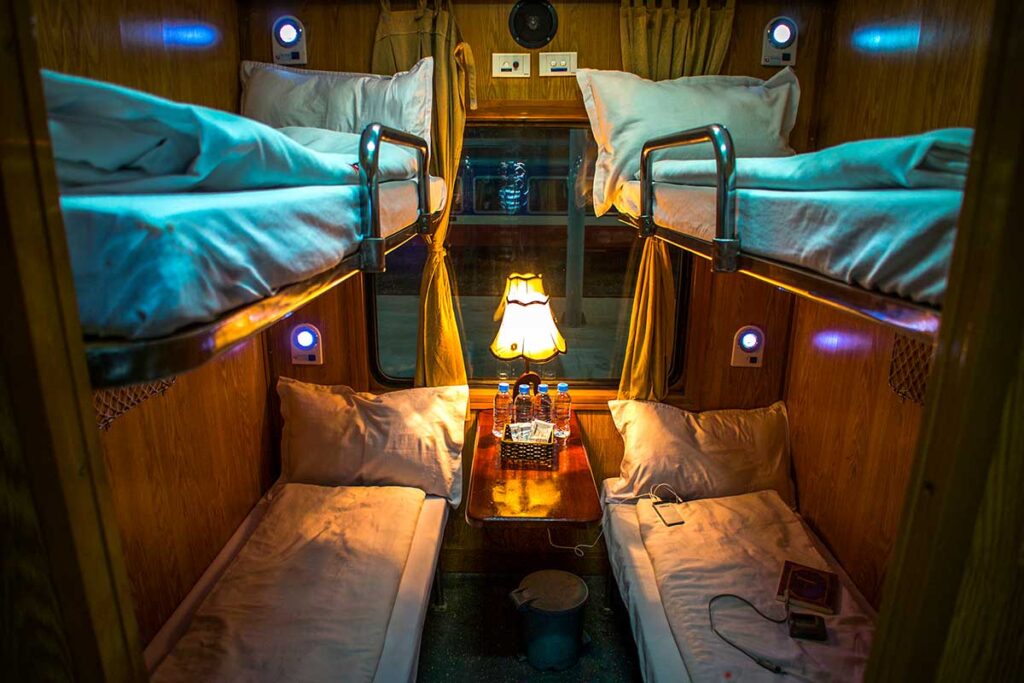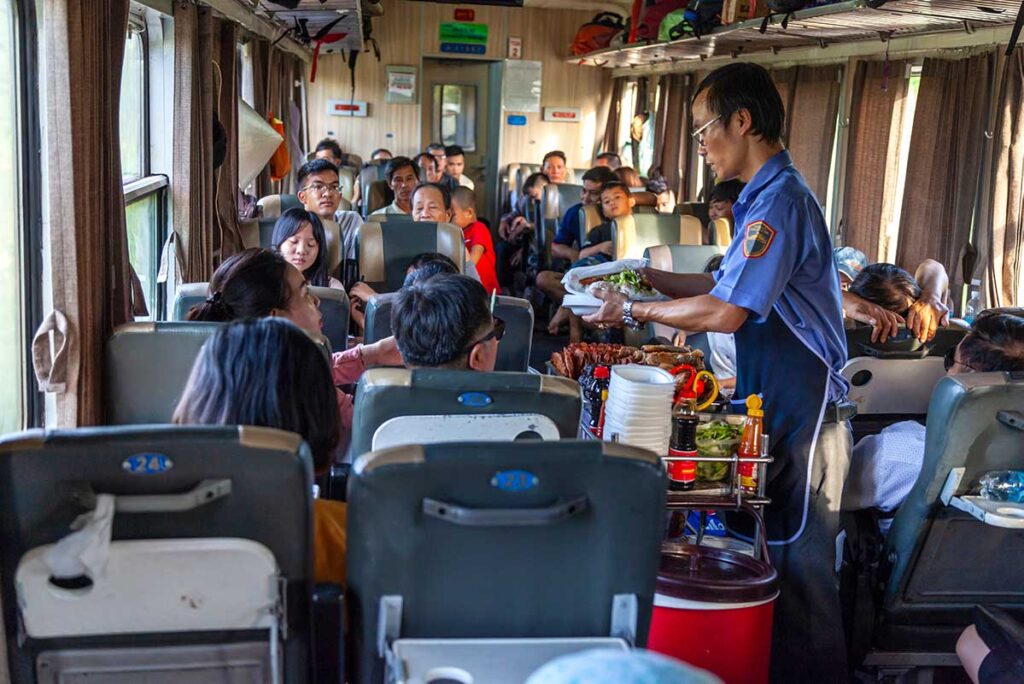Ever thought about swapping a standard bus ride for a scenic overnight adventure? Sleeper trains in Vietnam offer a unique way to travel between cities, combining transportation and accommodation into one experience. Let’s dive into everything you need to know.
The experience of using a overnight train in Vietnam
When to use it
- Long Distances: Perfect for covering large distances without the need for daytime travel.
- Overnight Travel: Ideal for those who want to save on accommodation costs by traveling overnight.
- Scenic Routes: Offers an opportunity to enjoy the Vietnamese countryside.
- Budget-Friendly: Often cheaper than flights and they save you the cost of a night in a hotel.
- Comfort: Sleeper trains are more comfortable than buses.
- Unique experience: Let’s face it, sleeping on a train is just plain cool! It’s a chance to slow down and see Vietnam differently.
Sleeping on the train

Traveling on a sleeper train in Vietnam can be a memorable experience. While the older tracks and slower speeds mean the journey can be a bit shaky, it’s generally possible to get a good night’s sleep. The train’s rhythm and the gentle rocking can even be soothing for some. However, taller travelers (over 6 feet or 182 cm) might find it challenging to fully stretch out and may need to lie diagonally.
Price
The cost of your ticket depends on a few things:
- Distance: Longer routes will naturally cost more.
- Class: You can usually choose between 4-berth compartments (a bit more private) or 6-berth compartments (more budget-friendly).
Example Routes & Prices (4-berth/6-berth):
| Route | 4-Berth Price | 6-Berth Price |
|---|---|---|
| Hanoi to Ho Chi Minh City | $70 | $50 |
| Hanoi to Da Nang | $55 | $35 |
| Ho Chi Minh City to Nha Trang | $45 | $30 |
| Hanoi to Hue | $50 | $30 |
Facilities on board
- Food & Drink: No restaurant car, but a cart usually comes by with snacks, meals, and drinks (both alcoholic and non-alcoholic).
- Bathrooms: Toilets are available, but cleanliness can be hit-or-miss. Bring your own hand sanitizer and tissues, just in case.
Luggage
- How much: No strict limits, but remember you’ll be sharing your space.
- Where to store it: Smaller bags fit under the berth. Larger suitcases might need to be stored between the beds.
Safety
Rail travel in Vietnam is considered very safe and generally safer than road travel. While theft is uncommon, it’s not impossible, so it’s wise to keep an eye on your belongings.
Punctuality
Vietnamese sleeper trains are surprisingly punctual. Although delays can occur, they are not the norm, making this a reliable mode of transportation.
Cleanliness of beds
Bedding is changed at both the departure and final stops. However, if you board the train halfway through the trip, your berth may have been used by a previous passenger.
Tourist sleeper trains
What is a tourist sleeper train?

A tourist sleeper train is not a separate train but consists of special wagons attached to regular trains. These wagons are owned by private companies that have upgraded them to be more modern and luxurious than standard sleeper train wagons. As a result, while the train schedule remains the same, the amenities inside these wagons are significantly improved. You can expect better-looking cabins, more comfortable bedding, and toilets that are not only cleaner but also better maintained.
Where to find tourist sleeper trains?
Tourist sleeper trains are becoming increasingly popular and are now available on more routes across Vietnam. The train from Hanoi to Lao Cai is particularly well-served, with many different companies offering tourist sleeper wagons. However, on other routes, you may find only one or two tourist train options.
What are popular companies?
Here are a few popular companies offering tourist sleeper trains:
- Victoria Express: Known for its luxurious and comfortable cabins.
- Sapaly Express: Offers modern amenities and well-maintained facilities.
- Orient Express: Combines comfort with a classic travel experience.
- Livitrans Express: Features upgraded wagons with excellent service and cleanliness.
How much do they cost?
Prices vary depending on the company and the level of luxury you’re after. Expect to pay significantly more than for a standard sleeper berth. To give you an idea:
- 4-berth cabin: Prices can range from $75 to $150+ per person, depending on the route and company.
- 2-berth cabin: More private, but also pricier, starting around $150 per person.
Seat options
Hard seat
This is exactly what it sounds like – a hard, upright seat. It’s the cheapest option, but definitely not recommended for overnight journeys. Unless you’re a master of napping in impossible positions, you’ll be pretty uncomfortable.
Soft seat

While more comfortable than a hard seat, the soft seat is still just that: a seat. It reclines a bit, but not enough for a good night’s sleep. Consider this option only for short daytime trips where scenery is the main attraction.
6-berth compartment
This is the standard sleeper option, and the most budget-friendly way to get a bed. It’s a small compartment with three bunk beds on each side. It’s not the most private or spacious setup, but it gets the job done if you’re mainly focused on sleep.
4-berth compartment

A slight upgrade from the 6-berth, this option gives you a bit more space and privacy. There are two bunk beds on each side, and it’s generally quieter and less crowded. If you’re splitting the cost with a friend or two, it can be a good value for the extra comfort.
Tips for taking a sleeper train
Sleeper trains during the day
Don’t be fooled by the name—sleeper trains aren’t just for nighttime! Many routes operate during the day, giving you a chance to enjoy the scenery while saving a bit of cash (daytime tickets are usually cheaper).pen_spark
Book a full cabin for privacy
Cabins on sleeper trains are typically shared, meaning if you book 2 berths in a 4-berth cabin, there’s a good chance the other 2 berths will be occupied by other passengers. If you prefer more privacy, you can book the entire cabin, even if it’s just for two people. This arrangement offers more privacy, potentially better sleep, and peace of mind for your luggage.
Eat dinner before you go on the train
The food options on board are limited, so it’s a good idea to have a proper meal before you get on the train. This way, you can settle in for the night without worrying about finding something to eat.pen_spark
Use a day pack
Keep your essentials handy in a small day pack. Your main luggage will be stored away, so you’ll want easy access to your phone, wallet, medications, snacks, and anything else you might need during the journey.pen_spark
Booking in advanced
Don’t leave booking your sleeper train until the last minute. These trains often get booked up a few days in advance, and during busy periods like Tet New Year, they can be fully booked weeks ahead.
Plan your onward journey
If you arrive very early at your destination, arrange for early check-in at your hotel so you can get some extra sleep. In places like Dong Hoi, where additional travel might be required to reach your final destination, it’s best to arrange transportation, such as a taxi, in advance.
What to bring
- Snacks: While there’s usually a food cart, options can be limited. Bring your own snacks to keep hunger at bay.
- Tissues and hand sanitizer: Not all trains provide these essentials, so pack them just in case.
- Warm clothes: The air conditioning can be chilly, so pack layers to stay comfortable.
- Portable charger: Outlets may be limited or occupied, so having your own power source is handy.
- Earplugs, noise-canceling headphones, and eye mask: These will help you get a good night’s sleep despite the noise and light.
- Entertainment: Bring a book, download some movies, or pack a deck of cards to keep yourself entertained during the journey.
- Your own pillowcase (optional): If you’re concerned about hygiene, bring your own pillowcase for extra comfort.
Popular sleeper train routes
Traveling by sleeper train in Vietnam can be a comfortable and scenic way to explore the country. Here are some of the most popular routes with detailed insights to help you plan your journey.
Hanoi to Lao Cai (for Sapa)
- Travel time: Approximately 8-9 hours
This is the most popular train route among travelers, especially those heading to Sapa for its stunning mountain views and vibrant ethnic markets. Despite the availability of a new highway that makes the trip quicker, the train ride offers a unique experience, especially due to the variety of nice tourist train options. It’s a truly memorable journey.
Hanoi (or Ninh Binh) to Hue (and beyond)
This route takes you through the heart of Vietnam, allowing you to start your journey in Hanoi or Ninh Binh if you plan to visit there first. This way, you don’t need to return to Hanoi. You can also stop at Dong Hoi to visit the impressive jungles and caves of Phong Nha.
From there, you’ll pass through picturesque countryside, eventually reaching Hue, the former imperial capital. Explore its ancient citadels and royal tombs before continuing your journey.
If you’re not interested in stopping at Hue, you can continue a bit further south to Da Nang, the gateway to Hoi An. However, the segment between Hue and Da Nang is one of the most scenic train routes in Vietnam, so make sure to travel this part during the day to enjoy the breathtaking views.
Travel time:
- Hanoi to Hue: Approximately 12-14 hours
- Ninh Binh to Hue: Approximately 10-12 hours
- Hue to Da Nang: Approximately 2-3 hours
Ho Chi Minh City to Da Nang
- Duration: Approximately 17-18 hours
This lengthy journey along the coast offers opportunities for beach hopping adventures. Consider stopping at Quy Nhon, a charming coastal town with beautiful beaches and a relaxed atmosphere. Continue on to Nha Trang, known for its vibrant nightlife and water sports. Or, venture further to Phan Thiet, where you can explore the stunning sand dunes of Mui Ne.
Nha Trang to Quy Nhon
- Duration: Approximately 4-5 hours
This route is known for its scenic countryside and coastal views. It’s a shorter but very picturesque train ride. The most luxurious train, The Vietage, operates on this track, offering an unparalleled experience for true train enthusiasts. While expensive, it promises a luxurious and unforgettable journey.
How to book train tickets
Booking train tickets in Vietnam can be done through various channels, each with its own advantages and considerations.
Official website or station
The official website to book train tickets in Vietnam is DSVN. Keep in mind that tickets can often be booked only up to one month in advance. It’s important to note that you cannot book tourist train tickets through the official website, and payment with foreign cards can sometimes be problematic.
You can also purchase tickets offline at the train station. This option requires you to plan time to visit the station, but it can be a straightforward way to secure your tickets.
Other websites to book trains
More user-friendly websites that also include tourist trains are:
- Baolau: Offers a comprehensive booking system for both standard and tourist trains, with a straightforward interface.
- 12Go Asia: Another reliable option for booking train tickets, including tourist trains, with easy payment options for international travelers.
Through a travel agency
Booking through a travel agency offers several benefits:
- Convenience: Agencies can handle the booking process for you, providing a hassle-free experience.
- Expertise: They can explain all the options and help you choose the best route and class for your needs.
- Flexibility: You can book both online before you go or offline once you are in Vietnam.
Keep in mind that booking through an agency can be more expensive due to markups. Ensure you book with a reliable agency and double-check prices to avoid overcharging.
Booking the complete package through Local Vietnam
If you’re looking for a hassle-free experience with everything taken care of, consider booking your entire trip through Local Vietnam. We can help you choose the right sleeper train, arrange transfers to your final destination (like Sapa or Phong Nha), book accommodations, and even organize activities like trekking or cooking classes. You’ll have peace of mind knowing everything is arranged in advance, but still tailored to your preferences.
Alternatives to sleeper trains
Buses
Pros:
- Often cheaper than trains, especially for shorter distances.
- More frequent departures on many routes.
- Can reach destinations not serviced by trains.
Cons:
- Can be less comfortable for overnight journeys.
- Traffic and road conditions can be unpredictable.
- Safety concerns on some routes.
Flights
Pros:
- Fastest way to travel between major cities.
- More comfortable than buses for longer journeys.
- Offers stunning aerial views.
Cons:
- Most expensive option.
- Less environmentally friendly than other modes of transport.
- Misses out on the scenic countryside.
Private Cars or Taxis
Pros:
- Flexibility to create your own itinerary and schedule.
- Door-to-door service.
- More comfortable and private than public transportation.
Cons:
- Can be expensive, especially for longer distances.
- Requires negotiating or pre-booking with reliable drivers.
- Contributes to traffic congestion.








